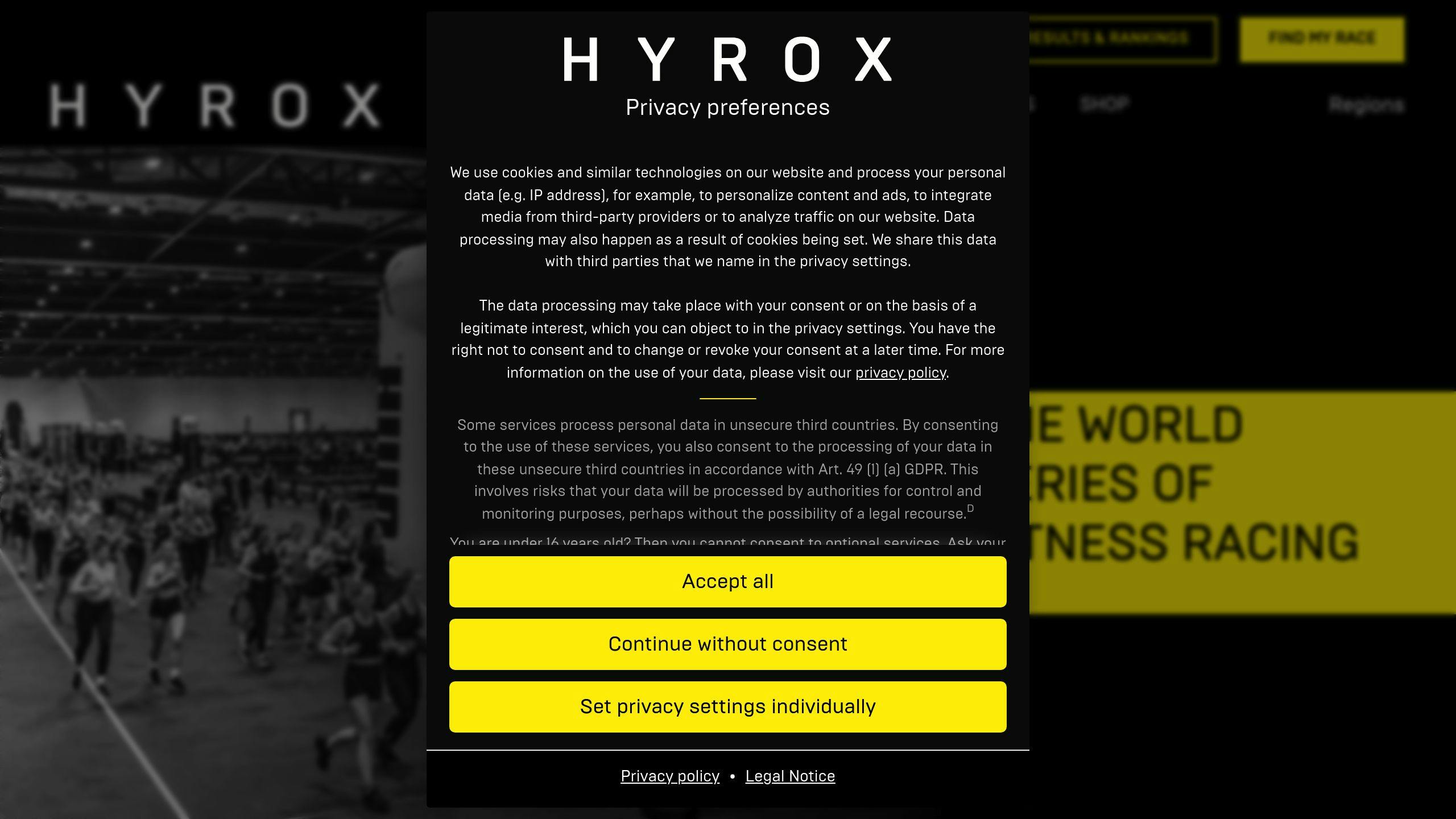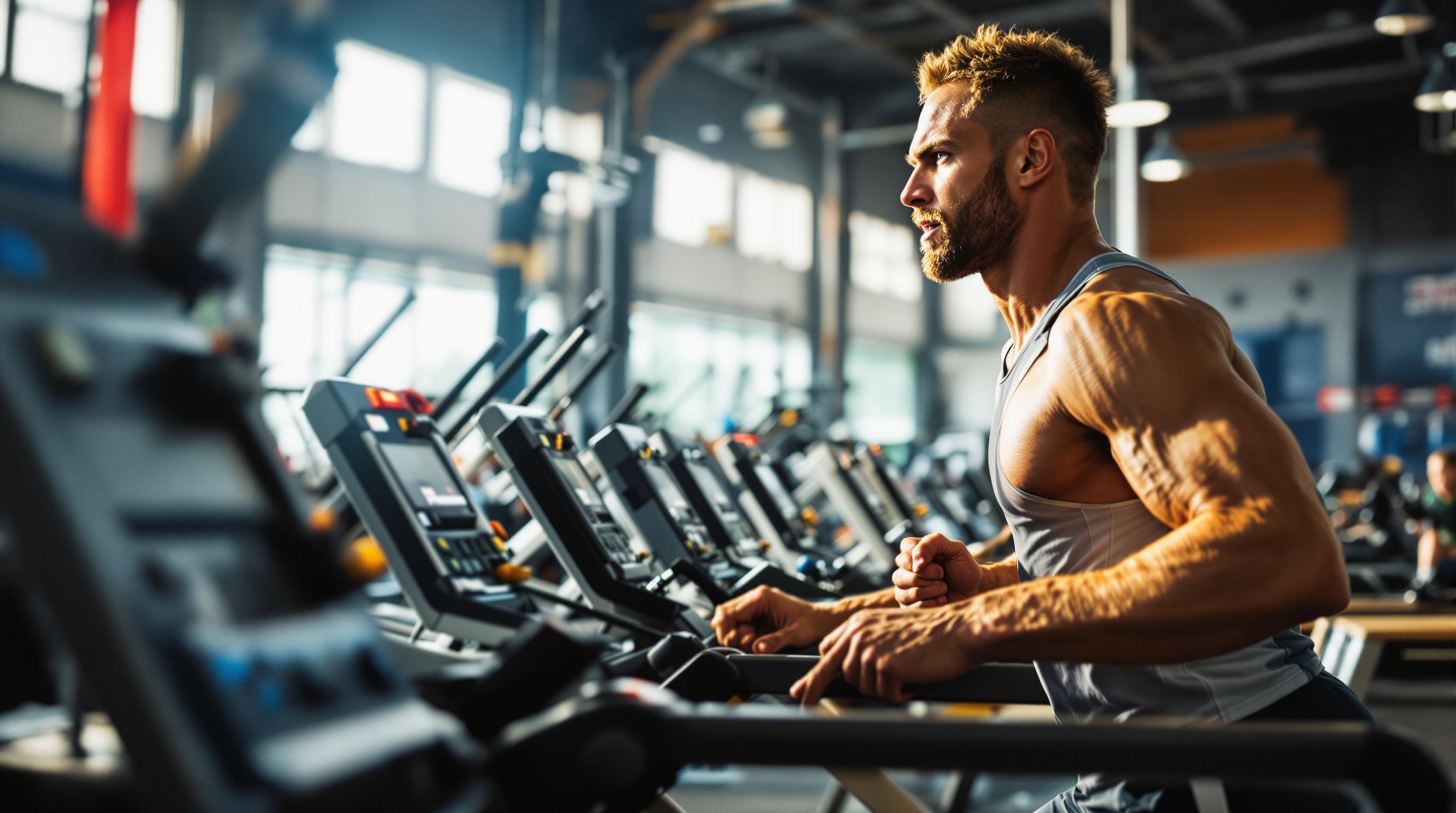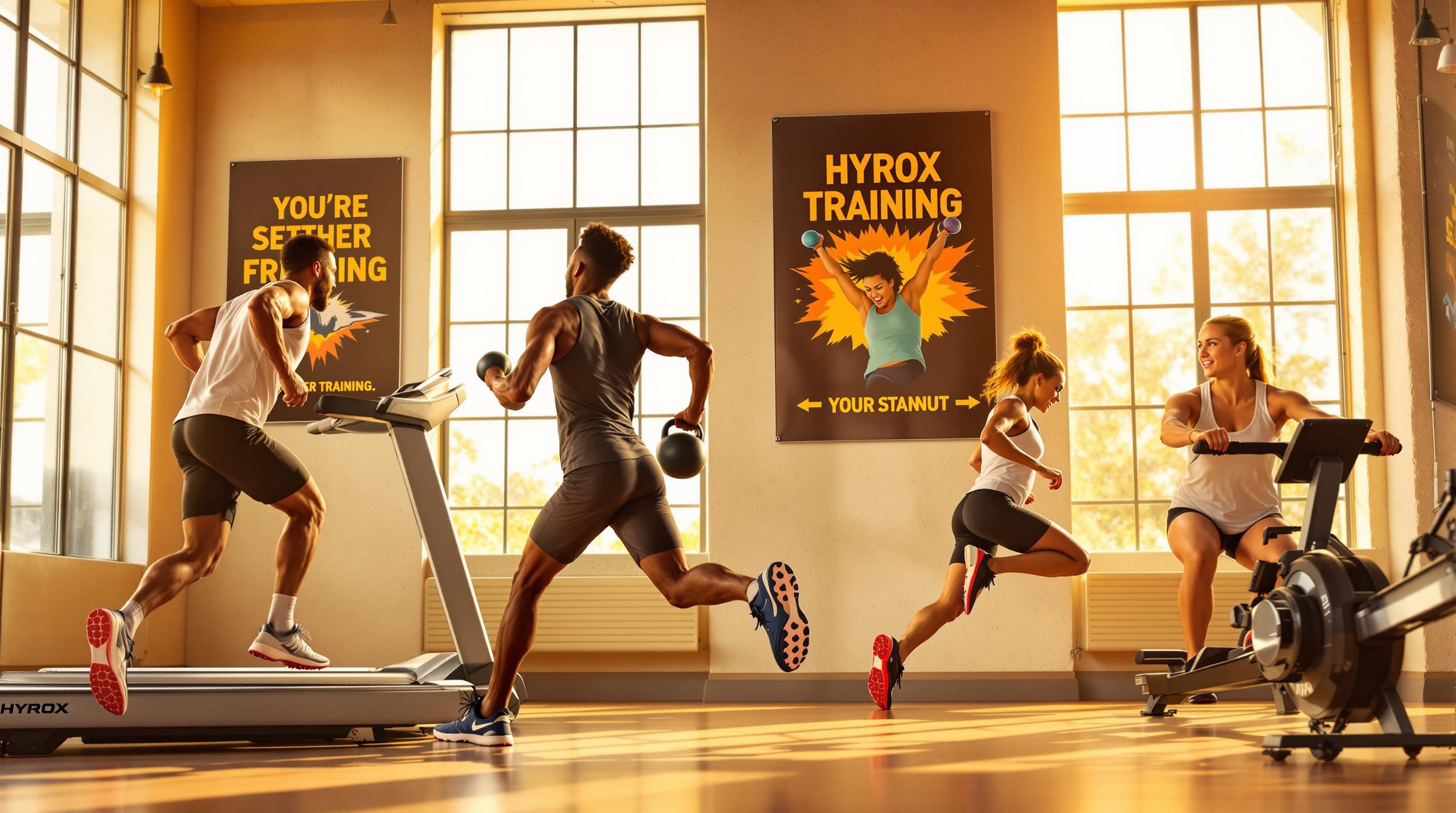Mindfulness is a powerful tool for Hyrox athletes, improving focus, endurance, and recovery. Practicing mindfulness helps manage stress, stay calm under pressure, and perform better during intense physical challenges. Here’s what you need to know:
-
Benefits:
- 13.5% longer endurance
- 30% less pre-race anxiety
- 20% faster recovery
- 7% better race times
-
Key Techniques:
- Before Training: 5-minute body scans and visualization.
- During Workouts: Breathing patterns like 2:3 for running or box breathing for sled work.
- Post-Workout: Progressive muscle relaxation and recovery meditation.
-
Race Day Strategies:
- 15-minute mindfulness routine (body scan, breathing, visualization).
- Focus on each station as a mini-task.
- Use positive self-talk to handle fatigue.
Mindfulness isn't just mental - it directly impacts physical performance. Adding 5-10 minutes daily to your routine can sharpen focus, reduce stress, and improve race outcomes.
Understanding Mindfulness for Athletes
What Is Mindfulness?
Mindfulness is about staying fully aware of your thoughts, emotions, and physical sensations in the present moment - whether you're training or competing. For Hyrox athletes, this means being entirely focused during every phase of the event, from the demanding wall balls to the exhausting sled pushes.
There are five main elements of mindfulness that are especially useful for functional fitness:
| Component | How It Helps Athletes |
|---|---|
| Present-moment awareness | Keeps focus on the current station or exercise |
| Non-judgmental observation | Recognizes fatigue without spiraling into negativity |
| Body scanning | Improves form and reduces the risk of injury |
| Breath awareness | Helps maintain steady, efficient breathing |
| Thought observation | Manages distractions during challenging moments |
Together, these elements provide a mental toolkit tailored to the specific demands of Hyrox competitions.
Benefits of Mindfulness for Hyrox Athletes

Research highlights mindfulness as a game-changer for athletes in high-intensity sports. For example, a 2021 study in the European Journal of Sport Science found that athletes practicing mindfulness extended their time to exhaustion by 13.5% during intense exercises [1].
Other studies, like those published in the Journal of Sport and Exercise Psychology (2020) and the Journal of Clinical Sport Psychology (2019), show even more ways mindfulness can boost performance:
- 13.5% longer endurance during high-intensity efforts
- 5% improvement in VO2 max after just 8 weeks
- 20% quicker recovery between intervals
- 15% sharper focus during workouts
- 30% reduction in pre-competition anxiety
- 25% decrease in overuse injuries [1][2]
Mindfulness isn't just about mental clarity - it's a practical tool for enhancing both performance and recovery.
Adding Mindfulness to Hyrox Training
Mindfulness Before Workouts
Start your training sessions with a quick, focused mindfulness routine. Spend 5 minutes centering yourself to sharpen focus and calm your mind. As elite Hyrox coach Mark Johnson explains: "The ability to stay focused and calm during the transitions between Hyrox stations can be the difference between a good performance and a great one. Mindfulness training is key to developing this skill." [6]
Here’s a simple pre-workout mindfulness plan:
- 2-minute body scan: Tune in to how your body feels.
- 3-minute visualization: Picture yourself executing key movements with precision.
Research backs this up - mental preparation combined with physical training can improve performance efficiency by up to 14% [3]. These quick rituals help align your mind and body for the unique challenges of Hyrox training.
Breathing Techniques During Workouts
Managing your breathing during intense Hyrox sessions is essential for staying focused and controlling fatigue. Use these breathing strategies to match different workout components:
| Exercise Type | Breathing Pattern | How to Apply |
|---|---|---|
| Running | Rhythmic 2:3 | Inhale for 2 steps, exhale for 3 steps |
| Wall Balls | Power Breathing | Exhale sharply as you release the ball |
| Sled Work | Box Breathing | Inhale, hold, exhale, and hold for 4 counts each |
| Recovery | Belly Breathing | Use deep breaths from your diaphragm |
Keeping your breath in check not only supports your endurance but also builds the mental toughness needed for race day.
Mindfulness After Workouts for Recovery
Mindfulness doesn’t stop when the workout ends. Post-session practices are key for recovery and setting yourself up for the next challenge.
Try these recovery-focused techniques:
- Progressive Muscle Relaxation: Dedicate 10 minutes to releasing tension, starting from your feet and moving upward. This method can lower cortisol levels by up to 20% [5].
- Recovery Meditation: Spend 5 minutes in a guided meditation to:
- Recognize where you feel fatigue.
- Celebrate the effort you put in.
- Set intentions for rest and recovery.
- Mindful Movement Cool-down: Combine stretching with controlled breathing to tune into your body’s recovery signals.
These practices not only help your body recover but also keep your mind engaged and ready for the next session.
Mindfulness Strategies for Race Day
Mental Prep Before the Race
Start your race day with a 15-minute mindfulness routine. This includes a 5-minute body scan to ease tension, 5 minutes of 4-7-8 breathing to calm your heart rate, and 5 minutes of course visualization to mentally prepare for efficient movement. These steps build on your regular mindfulness practices to help you perform at your best.
| Time | Activity | Purpose |
|---|---|---|
| 5 min | Body scan meditation | Ease physical tension |
| 5 min | 4-7-8 breathing | Calm your heart rate |
| 5 min | Course visualization | Prepare for efficient movement |
"Visualization primes the brain for success. When you've mentally rehearsed a perfect performance, your body is more likely to follow suit", explains sports psychologist Dr. Nicole Detling [4].
Staying Focused at Each Hyrox Station
Treat each station as its own mini-event to stay fully engaged. World champion Hunter McIntyre shares his approach:
"I break the race down into individual challenges. When I'm at a station, that's all that exists in my world" [2].
Use the mindfulness techniques you’ve practiced during training to stay present and focused during the race:
- Synchronize your breathing with your movements.
- Use mental cues tailored to each station.
- Focus exclusively on the task at hand.
By aligning your breath and focus with the demands of each station, you can maintain control and optimize your performance.
Handling Nerves and Fatigue During the Race
When fatigue or nerves hit, rely on the non-judgmental observation skills you’ve honed in training. Elite Hyrox athlete Lauren Weeks highlights the importance of resilience:
"The ability to bounce back from unexpected challenges often separates top performers. It's not about avoiding setbacks, but how quickly you can refocus and move forward" [5].
Here’s how to respond mindfully to common challenges:
| Situation | Technique | Benefit |
|---|---|---|
| Physical fatigue | Body acceptance technique | Boosts endurance |
| Mental blocks | Positive self-talk | Sharpens focus |
| Unexpected setbacks | 3-5 second mindful pause | Aids quick recovery |
| Loss of focus | Station-specific imagery | Improves technique |
These strategies can help you stay grounded and recover quickly, keeping you in control throughout the race.
sbb-itb-8bcd5e0
Tracking Mindfulness Impact on Hyrox Performance
Measuring Focus and Endurance
You can track how mindfulness affects your performance using these metrics:
| Metric Type | Measurement Tool | Target |
|---|---|---|
| Focus | Attention Network Test | Improved baseline scores |
| Endurance | Time-to-exhaustion tests | Longer duration at fixed intensity |
| Performance | Station timing | Faster split times |
| Mental State | RPE Scale (1-10) | Lower perceived effort |
An 8-week mindfulness program led to a 12% boost in time-to-exhaustion and a 25% drop in perceived exertion during intense intervals [2]. These metrics help set benchmarks to see how mindfulness impacts your race-day performance, which we'll explore in the next section.
Monitoring Recovery and Well-Being
Use wearables and personal journals to track how mindfulness influences your recovery and overall well-being.
"The improvements in mental resilience translated directly to physical performance enhancements", says Dr. Sarah Johnson, emphasizing the link between mindfulness and athletic recovery [7].
Focus on these recovery indicators:
| Recovery Metric | Target Improvement | Tracking Method |
|---|---|---|
| Heart Rate Variability | 5-10% increase | Morning readings |
| Sleep Quality | 7-8 hours optimal | Sleep tracking device |
| Muscle Soreness | Faster recovery time | Daily 0-10 scale |
| Resting Heart Rate | Gradual decrease | Morning measurement |
Consistently tracking these metrics strengthens the connection between mindfulness and recovery, reinforcing earlier findings.
Evaluating Performance in Competitions
To see how mindfulness affects your competition results, analyze your performance systematically. Look for improvements like better station consistency or faster overall times [7].
Key competition metrics to track include:
| Performance Area | Mindfulness Benefit |
|---|---|
| Overall Race Time | Faster completion |
| Station Efficiency | More consistent execution |
| Mental Resilience | Improved under pressure |
| Focus Maintenance | Sustained concentration |
For the best results, combine hard data with personal observations. Logging your mental state alongside workouts can provide a fuller picture of your progress.
Meditation for Athletes | 10 minutes Guided Meditation
Conclusion: Mindfulness and Hyrox Success
Mindfulness has proven to be a game-changer for improving Hyrox performance in several areas. Studies and athlete experiences highlight how it can provide real advantages on race day.
Here are some measurable benefits tied to mindfulness:
- 23% reduction in pre-race anxiety
- 7% improvement in race times
- 14% increase in station focus
Athletes who regularly practice mindfulness develop stronger mental resilience, which becomes invaluable during the toughest Hyrox stations. The secret lies in making mindfulness a consistent part of training - just as essential as physical workouts.
To maximize its impact, try integrating mindfulness into your training routine. As discussed earlier, structured plans can help streamline this process. Both research and top athletes agree: mindfulness isn’t an optional add-on - it’s a core part of preparing for peak performance. Combining mental and physical training ensures you're ready to tackle everything Hyrox throws your way.
FAQs
How to prepare mentally for HYROX?
Mental preparation plays a key role in standing out as a top HYROX athlete. Focused mindfulness techniques can make a big difference. Studies show that athletes who use these methods often see better results, such as improved focus and reduced stress. Here's a quick breakdown:
| Technique | How to Practice | Benefits |
|---|---|---|
| Visualization | Spend 15 minutes imagining yourself finishing the course. | Helps sharpen focus. |
| Breathing Exercises | Use box breathing during transitions and before the race. | Eases stress and tension. |
| Present-Moment Focus | Break the race into smaller, manageable stations. | Smoothens transitions. |
These strategies tie into the mindfulness practices covered in 'Mental Prep Before the Race.'
Starting with just 5 minutes of mindfulness daily, 8-12 weeks before the event, can lead to noticeable gains. For example, athletes have reported a 7% faster race time and a 15% drop in how hard the race feels.
Here’s how you can use these tools on race day:
- Use body scans to check your energy levels.
- Practice breathwork to stay calm and in control.
- Focus on each station to make smart tactical adjustments.



